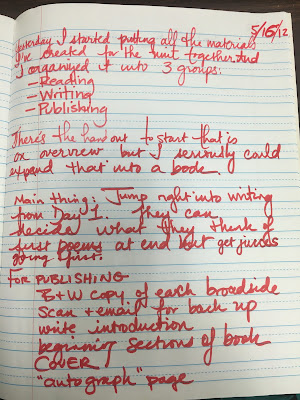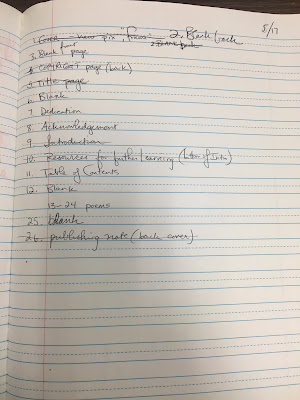 |
| Commonplace Book |
Making a Delicious Mess with Our Commonplace Books - The First of the Poetry of Science Elementary School Poetry Lessons
I start of the poetry unit by handing out blank notebooks to all the students. I tell them that these are their "Commonplace Books" and it's important that they put anything and everything in their notebooks: have cross-outs, take risks, fail, retry, re-write, go in one direction, stop, go in another, explore--in short: "make a delicious mess."
Inspiring Budding Poets
I also start addressing them as "poets" from the get-go. "Okay, poets, we're going to start the lesson." Calling them poets from the very beginning helps get them confident in their ability to be a poet -- which involves one, and only one, key ingredient: creating poems. Don't let anyone tell you otherwise. I say as much to the students, too.
Some are excited for the freedom. Other's are paralyzed by it. They're so used to making sure they do the right thing, they don't know what it's like when "the right thing" is to make mistakes.
I worked on my commonplace book before I handed ones out to them. I decorated it with stickers and drawings. I wrote a poem and made a drawing. I wrote down notes for the lessons of the unit. I wrote down other poems I liked. I made doodles and lists and cross outs and sketches.
I show them this, and more and more, they get the idea that their Commonplace Book is a real place to be free.
Wikipedia's entry on the commonplace book explains it well:
http://en.wikipedia.org/wiki/Commonplace_books
This post from the Beinecke Rare Books and Manuscripts library at Yale gives a good description og commonplace book and discusses the library's exhibition of their collection of commonplace books:
http://www.library.yale.edu/beinecke/compb.htm
This article from the Toronto Star covers an early commonplace book from the 15th century, though they characterize it as a precursor to Cosmo (???): http://www.thestar.com/news/gta/article/641640
Some are excited for the freedom. Other's are paralyzed by it. They're so used to making sure they do the right thing, they don't know what it's like when "the right thing" is to make mistakes.
I worked on my commonplace book before I handed ones out to them. I decorated it with stickers and drawings. I wrote a poem and made a drawing. I wrote down notes for the lessons of the unit. I wrote down other poems I liked. I made doodles and lists and cross outs and sketches.
I show them this, and more and more, they get the idea that their Commonplace Book is a real place to be free.
What Is A Commonplace Book?
Essentially they are scrapbooks filled with items of every kind: quotes, letters, poems, photographs, drawings, excerpts of other books...for modern day usage they can include blogs, photos, talks and readings, social media notes, and relevant articles. Additionally, you write in you own thoughts, commentary, lists, diary entries, and creative writing.Wikipedia's entry on the commonplace book explains it well:
http://en.wikipedia.org/wiki/Commonplace_books
This post from the Beinecke Rare Books and Manuscripts library at Yale gives a good description og commonplace book and discusses the library's exhibition of their collection of commonplace books:
http://www.library.yale.edu/beinecke/compb.htm
This article from the Toronto Star covers an early commonplace book from the 15th century, though they characterize it as a precursor to Cosmo (???): http://www.thestar.com/news/gta/article/641640
Frrreeeeeedommmmmm! The Students Fall in Love with Keeping a Commonplace Book
I can't even begin to tell you the amazing things I saw as I flipped through their commonplace books (with permission, of course). And I cannot share student pages, either, for privacy reasons. But I will describe it for you.
Having this unit on the heels of studying up for and taking the third grade MCAS (the standardized test 3rd graders take in Massachusetts schools), the assignment of keeping and filling a Commonplace Book is such a breath of fresh air. There are no grades, no wrong way to do this (except for just not doing it altogether), and they're actually encouraged to make mistakes as opposed to the constriction of right or wrong answers on the standardized tests they just slogged through. (Did I mention I hate standardized tests? I do. A lot.)
By the time we were done with the unit, everyone had filled at least one notebook each, some were on their second or even third. They loved the possibilities of filling a page with their creative and critical thinking.
I saw comic strips, lists, cross out, doodles, contemplations on words, other poems they liked, journal entries, their own poems, drawings, song lyrics, letters to fictional characters, or other poets we studied (like to Emily Dickinson), in short: everything!
Eight Year Olds' Illustrating "Concrete vs Abstract"
I taught the concept of concrete vs abstract to the students. I showed them two paintings from the same year in the 1960s, but by vastly different painters: Norman Rockwell and Mark Rothko. (I'll post that lesson in a future blog post.) Later, when I flipped through commonplace books, I noticed a small group had done their own entries on Abstract vs Concrete. They had pages in marker using red, yellow, green and blue, with a drawing of something simple, like a house with a yard and flowers. Underneath they wrote "Concrete." On the next page were these random splatters and squiggles and lines in the same colors making Pollack-esque drawings. Underneath which they wrote "Abstract."
I was so impressed with the cuteness, creativity, and deep understanding these young poets were demonstrating. It still moves me today. Love it!
More Ideas for Commonplace Books
While I can't share their pages, I will share the rest of mine, below. They have all kinds of content on the pages, as you can see.
 |
| commonplace book - to do list |
 |
| commonplace book - notes on a lesson |
 |
| draft checklist for finishing touches on the published poem for elementary school poetry lesson |
 |
| poetry of science poetry lesson for elementary school students notes followed by my own drafts of haiku |
 |
| notes on organizing my materials for the elementary school poetry lessons and overall unit |
 |
| sketching out the table of contents for the final published book in my commonplace book |
As you can see I do that tried-and-true method of teaching by modeling for the students how they can utilize their commonplace books for everything. As they worked on theirs, I also worked on mine and jotted down lists, ideas, lesson plan drafts, my own poems, the table of contents for the book and even how to organize all the material I had created for the unit.
It's fun to keep a commonplace book, for students and teachers, kids and adults alike!
See all the blog posts about "Poetry of Science: an elementary school poetry unit for teaching poetry to young students" at:
https://www.anartsnotebook.com/search/label/poetry%20of%20science
The Poetry of Science Blog Posts
See all the blog posts about "Poetry of Science: an elementary school poetry unit for teaching poetry to young students" at:
https://www.anartsnotebook.com/search/label/poetry%20of%20science



